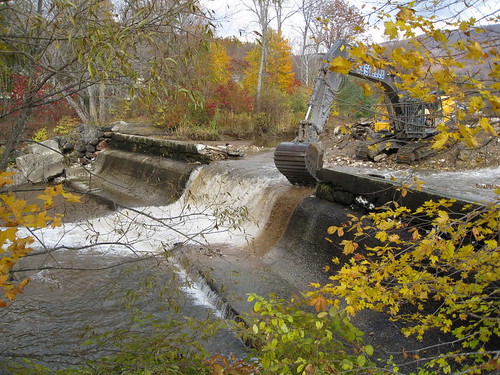Fifteen hardy New Englanders stood in the cold November rain recently to watch the demolition of one of the largest dams ever to be removed in Massachusetts. The crowd was made up of representatives from a diverse group of public and private partners that have been working together toward this day. The removal of the Briggsville Dam in Clarksburg, a small town near the Vermont border, will restore the North Branch of the Hoosic River.
The 15-foot-high, 145-foot-long dam is being removed to improve wildlife habitat, restore natural river functions and reduce the risk of flooding. USDA’s Natural Resources Conservation Service provided more than half of the funding for the dam’s removal through its Wildlife Habitat Incentives Program.
The restoration will improve over 30 miles of high quality headwater streams and will benefit native coldwater fish species that rely on cold, swiftly moving, oxygenated water to support their spawning, including Eastern brook trout, slimy sculpin, longnose sucker. The longnose sucker is a state-listed species of concern.
The dam is owned by Cascade School Supplies, which purchased a building on the banks of the Hoosic River, and the dam with it, about five years ago. Shortly thereafter, the Massachusetts Office of Dam Safety classified the dam as needing significant repairs. The company faced closing if it had to fund the dam repairs, laying off 150 people and ending a 78-year relationship with the community.
NRCS provided more than $350,000 in financial assistance for the project, as well as technical help. Other conservation partners provided an additional $200,000.
Since it was constructed in 1848 to provide power to woolen textile mills – the last of which shut down in 1970 – the Briggsville Dam has blocked upstream movement of aquatic species, changed the flood regime, increased water temperatures and altered the movement of beneficial sediment downstream.
To remove the dam, a contractor first prepared the site by removing sediment and cutting a notch in the dam to slowly release water. Then11,000 cubic yards of concrete and masonry structure were broken up and removed with heavy machinery. Later the banks will be stabilized and planted with native grasses and other plants.
In addition to NRCS and Cascade, project partners include American Rivers, the Town of Clarksburg, the Massachusetts Division of Ecological Restoration, MassWildlife, the U.S. Fish and Wildlife Service and many others.

